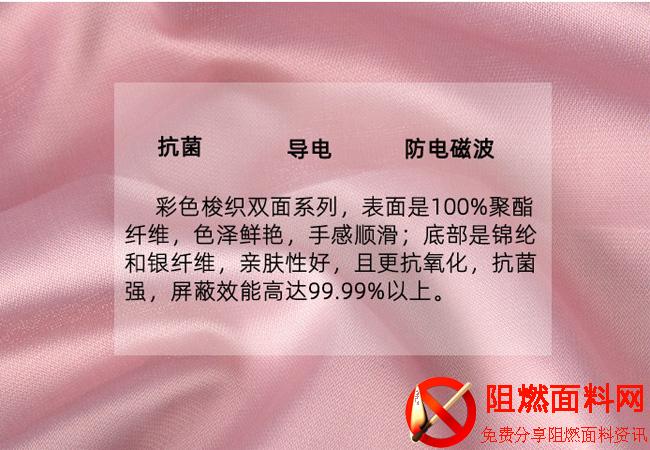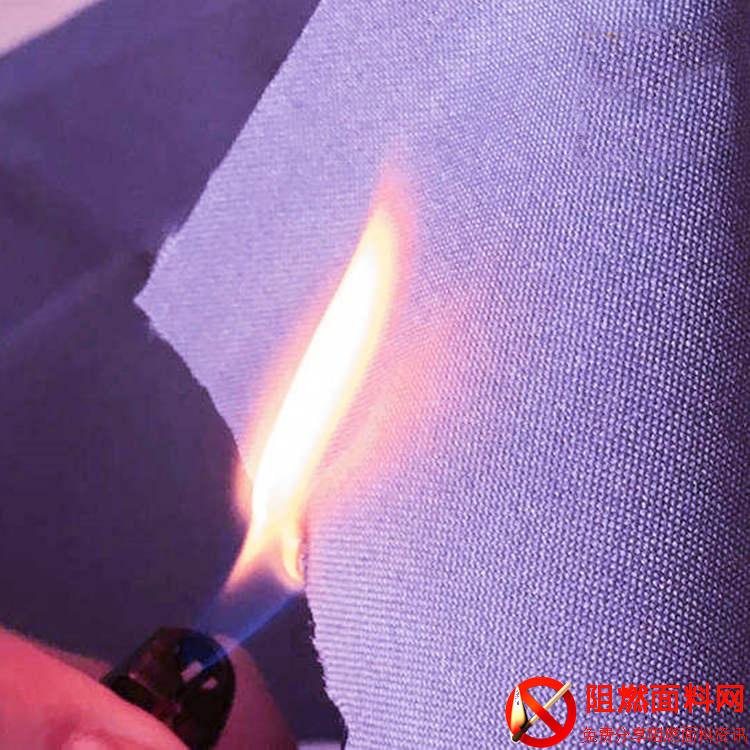Introduction to flame retardant fabrics
Flame retardant fabricIntroduction
01
The concept of flame retardant fabrics
Flame retardant fabrics are special fabrics that can delay the burning of flames. It does not mean that they will not burn when in contact with fire, but that they can extinguish themselves after isolating the fire source. Generally divided into two categories, one is the fabric that has been processed to make it flame retardant, such as polyester, pure cotton, polyester cotton, etc.; the other is the fabric itself that is flame retardant, such as aramid, nitrile cotton, DuPont Kevlar, Nomex, Australian PR97, etc. According to whether it has flame retardant function after washing, it can be divided into washable, semi-washable, disposable and permanent flame retardant fabrics.
Polyester flame retardant fabric is finished with new ATP flame retardant. It has the characteristics of water resistance, excellent flame retardant effect, good hand feeling, non-toxic and safe. This product does not contain halogen and complies with ecological and environmental protection requirements. Its main technical indicators are at the international level. The flame retardant index of polyester flame retardant fabrics can reach national standard B2 or above. It can be washed more than 30 times.
Pure cotton flame-retardant fabric, finished with new CP flame retardant, has the characteristics of water absorption resistance, good flame retardant effect, good hand feel, non-toxic and safe. This product complies with ecological and environmental protection requirements, and its main technical indicators are at the domestic level. The flame retardant index of polyester flame retardant fabrics can reach national standard B2 or above. It can be washed more than 20 times.

Nomex permanent flame retardant fabric is made of innate flame retardant fibers through spinning, weaving and dyeing. The fabric has the characteristics of flame retardant, wear-resistant, temperature-resistant, washable, acid and alkali resistant, waterproof, anti-static, high strength, etc. It is an ideal fabric for making protective clothing in metallurgy, oil fields, coal mines, chemical industry, electric power, and fire-fighting industries. .
Typical flame retardant fabrics are as shown in the table above
02
Flame retardant fabric machine
In actual production applications, the organizational structure and fiber content of textile fabrics are different, and the corresponding types of flame retardants are also different. Therefore, the actual flame retardant effect and flame retardant mechanism are not determined in a single way. The flame retardant mechanism of flame retardants may involve the combined effect of the following flame retardant mechanisms.
1. Covering layer flame retardant mechanism
Flame retardant covering is a chemical change that occurs when the flame retardant is heated and burns, producing flame-retardant substances on the surface of the textile fabric, forming an insulating covering layer.
This covering film can block the interaction between the fabric and oxygen and heat sources, and can hinder the diffusion of flammable gases, thus playing a flame retardant role. Both inorganic and organic flame retardants have a covering flame retardant mechanism. For example, ammonium polyphosphate flame retardants adopt a covering flame retardant mechanism.

2. Vapor phase flame retardant mechanism
There are two main theories for gas phase flame retardant mechanism: one is gas dilution theory. Since the flame retardant is thermally decomposed to produce non-flammable gases, the concentration of flammable gases is diluted, resulting in insufficient oxygen during the burning process of the fabric, thereby achieving the flame retardant effect.
The second is the free radical theory. The thermal cracking products of flame retardants can interrupt the combustion chain reaction, because the cracking products can capture a large amount of high-energy oxygen free radicals and hydrogen free radicals during the combustion process, thereby exerting a flame retardant effect.
3. Decompose the endothermic flame retardant mechanism
Flame retardants undergo endothermic decomposition reactions such as phase change, dehydration, etc. when heated. Because the flame retardant can absorb a certain amount of heat energy and reduce the heating of the fabric, it reduces the thermal decomposition of the fabric and the generation of flammable gases.
4. Dehydration and carbonization flame retardant mechanism
During the heating process, the flame retardant promotes the dehydration, cyclization and cross-linking processes of the fiber by changing the thermal cracking of the fiber, thereby forming a carbon layer.
The formation of the carbon layer can reduce the generation of flammable gases and can also cover and insulate fabrics. Most of the flame retardants that work with this flame retardant mechanism are phosphorus-containing flame retardants. It is generally believed that phosphates and organic phosphate compounds have a flame retardant effect because they undergo an esterification reaction with the hydroxyl groups in the fiber macromolecules, preventing the formation of L-glucose, further dehydrating the cellulose, and generating unsaturated double bonds. It speeds up the cross-linking reaction between cellulose molecules, increases the carbon residue generation rate of the fabric, and achieves the purpose of flame retardancy.
5. Droplet effect
Some thermoplastic synthetic fibers, such as polyamide and flame-retardant polyester, shrink and melt when heated, reducing the contact area with air, and even droplets may fall and leave the fire source, which hinders combustion to a certain extent. Blended fabrics of cellulose fiber and polyester fiber, because the cellulose fiber does not melt and hinders the droplet action of polyester, making their flame retardant modification more difficult
6. Wall effect of dust particles
When free radicals come into contact with the wall or dust particle surface, they may lose activity. in dust particles or containers
Japanese standard: JIS L 1091-1999 “Test method for flammability of textiles”;
Chinese Standard: GB/T 5455-2014 “Textiles – Combustion Properties – Determination of Vertical Damage Length, Smoldering and Afterburning Time”.
2. 45° slope detection method
The 45° inclined plane detection method refers to a method where, under specific circumstances, the sample is placed at an angle of 45°, the sample ignition time is 1s, and the burning flame is a certain distance required to evaluate the burning intensity of a fabric. , a detection method through continuous burning and measuring the smoldering time of the sample, the damage zone and measuring the length of the flame retardant effect of the fabric.
American standard: 16CRF part1610 “Standard for Flammability of Clothing Textiles”;
Canadian standard: CAN/CGSB-4.2 No.27.5 “Textiles 45°-1s Flame Impact Test”;
Chinese standards: GB/T 14644-2014 “Combustion properties of textiles – Determination of burning rate in 45° direction”; GB/T 14645-2014 “Combustion properties of textiles – Determination of damage area and number of flame contacts in 45° direction”.
3. Level detection method
The horizontal detection method refers to a fabric sample in a horizontal direction in a specific environment with an ignition time of 15 seconds. The flame spread is measured by the flame spread and the flame spread speed is obtained by the distance and time. The spread sample is measured to measure the resistance of the fabric. A method of detecting the effect
Japanese standard: JISL 10911-1999 “Test method for flammability of textiles”;
Chinese Standard: FZ/T 01028-1993 “Textile Fabrics – Determination of Combustion Properties – Horizontal Method”;
GB/T 8410-2006 “Combustion Characteristics of Automotive Interior Materials”.
4. Limiting oxygen index detection method
The limiting oxygen index detection method refers to the minimum oxygen concentration of the fabric candle required to maintain combustion in the combustion gas mixture of oxygen and nitrogen. The higher the limiting oxygen index, the product has better flame retardant effect, otherwise the flame retardant effect Deteriorated or not flame retardant.
Although high sensitivity is the advantage of the limiting oxygen index detection method, the test conditions and operator requirements are very high, and the actual situation of the tested fabric is very different. Therefore, the oxygen concentration of the limiting oxygen index method is very Suitable for scientific research test equipment, not frequently used in production processes.
Chinese standard: GB/T 5454-1997 “Textile fabrics – Determination of combustion properties – Oxygen index method”.
05
The future development trend of flame retardant fabrics
With the continuous improvement of people’s living and environmental conditions in our country, people have higher and higher requirements for the performance of flame-retardant textiles. At present, most flame-retardant fibers or fabrics only have flame-retardant properties and cannot meet the special requirements of some departments, such as flame-retardant and water-repellent, flame-retardant and oil-repellent, flame-retardant and antistatic. It is imperative to develop flame-retardant multi-functional products.
For example, various forms of production methods are combined to treat flame-retardant fiber fabrics with waterproof and oil-repellent treatments; flame-retardant fiber yarns are interwoven with conductive fibers to produce antistatic flame-retardant fibers; flame-retardant fibers and high-performance fibers are used Blended and interwoven to produce high-temperature-resistant fabrics; flame-retardant fibers are blended with fibers such as cotton, viscose, etc. to improve the comfort of the final product and reduce costs.
At the same time, we are developing flame retardants that are efficient, non-toxic and have little impact on material properties. This leads to the development of reactive flame retardants and the development of additive flame retardants with better compatibility; the development of flame retardants with synergistic effects, such as phosphorus, nitrogen, and bromine in molecules or intermolecular combinations; the development of flame retardants with A series of flame retardants for different application ranges, etc. These will be the trends and directions of future development.






